|
The Matrix Reloaded
The Animatrix
|
| |
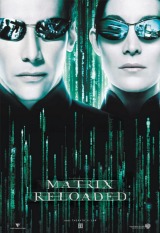 |
USA, 2003. Rated R. 138 minutes.
Cast:
Keanu Reeves, Carrie-Anne Moss, Lawrence Fishburne, Hugo Weaving, Harold
Perrineau, Monica Bellucci, Lambert Wilson, Anthony Zerbe, Jada Pinkett-Smith,
Randall Duk Kim, Gloria Foster, Nona M. Gaye
Writers: The Wachowski Brothers
Original Music: Don Davis (score), Juno Reactor (score remixes/songs),
and songs by Rob Zombie, Marilyn Manson, et al.
Cinematography: Bill Pope
Producer: Joel Silver
Directors: The Wachowski Brothers
Grade:
B
|
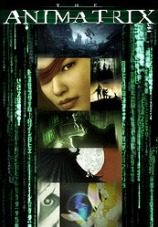 |
USA, 2003. Not rated. 102 minutes.
Voice Cast:
Clayton Watson, Carrie-Anne Moss, Keanu Reeves, Victor Williams, Phil
LaMarr, Kevin Michael Richardson, Pamela Adlon, Tara Strong, James Arnold
Taylor, Hedy Burress, Mindy Clarke
Writers: The Wachowski Brothers ("The Second Renaissance Parts
1 and 2," "The Final Flight of the Osiris," "Kid's Story"), Peter Chung
("Matriculated"), Yashkiaki Kawajiri ("Program," "World Record"), Shinichiro
Watanabe ("A Detective's Story")
Music: Don Davis
Producers: Michael Arias, The Wachowski Brothers
Directors: Peter Chung ("Matriculated"), Andy Jones ("The Final
Flight of the Osiris"), Yoshiaki Kawajiri ("Program"), Takeshi Kioke ("World
Record"), Kouji Mormoto ("Beyond"), Mahiro Maeda ("The Second Renaissance
Parts 1 and 2"), Shinichiro Watanabe ("Kid's Story," "A Detective's Story")
Grade:
C+
|
| |
Review and analysis by Frances
Nicole Rogers |
 he
first Matrix film did not have a perfect or original story. The journey
of Thomas Anderson (Keanu Reeves), a.k.a. Neo, from discontented computer programmer
to gifted messiah figure was just a rehash of different heroic tales familiar
to our culture. Familiarity, however, did not make The
Matrix any less riveting. It wasn't perfect, it wasn't ideal, but it
was a story that had progression and conflict. No action sequence felt out of
place or gratuitous. Like a musical's numbers, The Matrix's action sequences
were essential to developing the plot and the characters, Neo in particular.
He progressed from a man who chickened out of an elaborate escape in one scene,
to a man who planned an elaborate rescue mission in another, and from a man
who didn't know how to deal with Agents to a man who managed to delete the same
Agent who defeated him a few scenes prior.
he
first Matrix film did not have a perfect or original story. The journey
of Thomas Anderson (Keanu Reeves), a.k.a. Neo, from discontented computer programmer
to gifted messiah figure was just a rehash of different heroic tales familiar
to our culture. Familiarity, however, did not make The
Matrix any less riveting. It wasn't perfect, it wasn't ideal, but it
was a story that had progression and conflict. No action sequence felt out of
place or gratuitous. Like a musical's numbers, The Matrix's action sequences
were essential to developing the plot and the characters, Neo in particular.
He progressed from a man who chickened out of an elaborate escape in one scene,
to a man who planned an elaborate rescue mission in another, and from a man
who didn't know how to deal with Agents to a man who managed to delete the same
Agent who defeated him a few scenes prior.
The Matrix was a rarity in a genre that spends less time building character
and plot and more time blowing things up. It was praised as an intelligent action
film because of its philosophical and religious themes, inspiring several to
write analytical essays (some of which can be found on the film's official site)
and books. But it seems that during the birth of the Matrix franchise,
something very important was lost: a good story.
Few of the Matrix-related spin-offs and sequels develop or add to the
central story of the original Matrix—not the online comic strips
(on the official site), the nine Animatrix shorts (an experiment between
the Wachowskis and various Japanese animation directors), or even The Matrix:
Reloaded itself.
The Animatrix is not much more than an interesting experiment. None
of its shorts has a plot, nor do the shorts form a solid narrative. Several
digress into irrelevant scenes, like the striptease swordfight in "The Final
Flight of the Osiris" (a Wachowski-scripted "prequel" to The Matrix: Reloaded
made by the filmmakers behind Final Fantasy: The Spirits Within). Others,
like Peter Chung's "Matriculated," are too abstract to successfully tell what
could've been a good story.
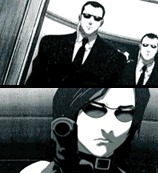
Images from The Animatrix. |
With the exception of "Kid's Story" and "A Detective's Story," all the shorts
are failures. "The Second Renaissance Parts 1 and 2," directed by Mahiro Maeda,
show the growing tensions between man and machine that lead to the war described
in the first movie and the creation of the Matrix, but have the disturbing effect
of making the viewer side with the machines. Aren't we supposed to be rooting
for the humans? "Osiris" is an unfocused blunder, mostly an attempt to show
off what was already seen in Final Fantasy and to promote Reloaded.
"Cowboy Bebop" creator Shinichro Watanabe's shorts ("Kid's Story" and "A Detective's
Story," both of which feature characters from the movies) would have benefited
from a longer-running length. As it is, "Detective's Story" is the best short
in the series, bound to be a favorite among film noir buffs. Second to this
is "Beyond" (directed by Kouji Mormoto), a cute short about a young woman who,
while searching for her cat, comes across a haunted house that is actually a
glitch in the Matrix. The most straight-forward short, "Program" (by Yoshiaki
Kawajiri), occurs in an impractical training simulation where two shipmates
spar over whether to return to the Matrix, is a redundant echo of Cypher (Joe
Pantoliano) from the first film.
The absence of narrative in The Animatrix is more forgivable than in
The Matrix: Reloaded, a disappointing sequel to a magnificent film that
nearly regresses to the status of "just another action flick" via its tendency
to slip into action sequences that do little to advance the plot. Its role in
the series seems to be as an advertisement for everything else in the franchise
(as satirized in an online
parody where the Architect's answers for Neo's questions can all be found
in The Animatrix, Enter the Matrix, The Matrix: Revolutions, and a bottle
of Powerade). Yet the film is redeemed by three thrilling and beautifully filmed
action sequences, and by the stimulating bombshells it drops about the true
nature of the Matrix and the role of the One (discussed later in this commentary).
Reloaded takes place six months after The Matrix ends. The war
is escalating, and the tension is high for the soldiers due to the discovery
of some half-million machines digging their way towards Zion, the last human
city, which we hear about but never visit in the first film. Amid this tension
is the division between people who do not believe in the prophesy of the One
and those who do, like Morpheus (Laurence Fishburne) and Trinity (Carrie-Anne
Moss). Regardless, the folks down at the Nebuchadnezzar do what they do to help
save the world from the evil of the Matrix. The time is soon coming when Neo
will have to end his path as the One by ending the war.
After making a pit stop at Zion, where he, Trinity, and other Zionites get
sweaty to the beat of a song that makes up for a throwaway scene, Neo and company
wander about the Matrix fighting various rogue programs (including but not limited
to the minions of the Merovingian, played by Lambert Wilson, and the clones
of returning character Agent Smith, played by Hugo Weaving) in the search for
the Keymaker (Randall Duk Kim) and the way to the Source.
Reloaded offers little insight to who or what the One is outside of
his role in the makeup of the Matrix. What makes Neo more special than other
rebels other that he can fly, stop bullets, and fight agents (a rather moot
point, since Morpheus kinda-sorta holds his own against on atop a truck)? What
is his relationship to the increase of "freed minds" in the six month span between
The Matrix and Reloaded? And how has being the One changed him?
It would have been nice to see some sort of development in his character other
than more self-confidence. It also appears that, by all the new advertisements
for Revolutions, the final film will explore more deeply just what makes
the One special.
The Neo of Reloaded is less appealing than the goofy, unconfident Thomas
Anderson of The Matrix. The latter was a sympathetic character; the former,
a reserved, distant character who we can't understand outside of his passionate
love for Trinity. This makes rooting for him difficult, especially in the presence
of charismatic villains like the Merovingian and Agent Smith. The same is true
for the other good guys: They are all stripped of what character they had, replaced
by cold, monotonous philosophers who seem self-conscious of their icon status.
The warm performance of the late Gloria Foster (the Oracle) and the psychotic
antics of Weaving are wanted respites from the predominant deadpan of the cast.
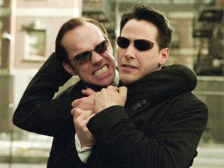
Neo (Keanu Reeves) attempts a choke hold on Agent
Smith (Hugo Weaving) in The Matrix: Reloaded |
To the credit of the Wackowskis, the tiresome opening of Reloaded is
redeemed by two consecutive action sequences. The first—a swordfight between
Neo and some vampires (yes, there are vampires in the series now; they are manifestations
of rogue programs) in the Merovingian's house—is only an appetizer for
the following, the much lauded freeway chase, which remains, out of many, the
best chase sequence of this past summer. Regardless that it seems much ado about
nothing (for Trinity and Morpheus' objective is not clear), it is closest to
the progressive sequences in the original. The intensity of the chase is raised
so high that a character's exclamation of relief at the end is funny because
it is what the audience feels. (The character Link, played by Harold Perrineau,
a replacement for the mysteriously absent Tank, often is a humorous commentator,
notably during the action sequences.) The movie also opens with a spectacular
fight and free fall shoot-out between Trinity, an Agent, and a handful of unsuspecting
security guards. This is the only scene in Reloaded that uses bullet-time.
The special effects, contrary to advertising claims, are disappointing. While
they succeeded in cloning Hugo Weaving, they did not succeed in creating CGI
that could compete with the likes of The Lord of the Rings. CGI replacements
for characters look fake—so fake that they distract the viewer. It's a
pity that only once does Reloaded use the special effect that defined
The Matrix.
NOTE: THE REST OF THIS ANALYSIS CONTAINS SPOILERS! DO NOT CONTINUE IF YOU
HAVE NOT SEEN "RELOADED."
Even if Reloaded has no story, it is a puzzle quite fun to dissect.
Here I am going to address some of the theories I've seen. Note that while there
are only two subjects listed, I will cover several related ideas within these
sections.
The Double Matrix
The popular Double Matrix theory suggests that the "real world" (Zion) is a
fake, another simulation of the Matrix. The ease with which this conclusion
can be reached makes me inclined to believe it isn't true; it's just a quick
way to explain Neo's sudden ability to sense/control the Sentinels at the end
of the film. He could even be a computer program—they all could
be computer programs, which would explain all the references to Neo's "code."
If the real world is not real, then what is? Is the "man vs. machine" conflict
a lie? Is this a case of man controlling machine, machine controlling machine,
aliens controlling man and machine, or some geeks playing a video game? The
possibilities are endless, which makes the theory ultimately unconvincing—any
legitimate theory would be definite, not indefinite.
The first "hint" to the Double Matrix theory is Agent Smith's ability to take
over Bane, a member of the resistance, both in the Matrix and in the real world.
That Smith, a computer program, can possess a human like a ghost or a demon
seems too far-fetched to be believable; yet no one has questioned any previous
example of events in the Matrix affecting the real world. Did anyone think there
was a double Matrix when Mouse and Neo died in the first film? Did anyone question
how information could be "uploaded" into the brain? We have seen that things
in the Matrix can and do affect real life, and we have seen this without any
"hints" that the real world is a fake. It is entirely possible that, if things
can be "uploaded" into someone's brain, then something can be "downloaded" as
well—the brain, in this universe, is a computer.
The second "hint" is the spoon Neo receives just before he leaves to meet the
Oracle. This is a reference to the first movie. It doesn't mean anything. In
fact, if my eyes weren't being deceptive, Neo looked amused, and nowhere near,
"Dude, this might Mean Something." Also, Kid's convenient interruption prevents
Smith-possessed Bane from stabbing Neo with the knife he had in his hand. There
are several such conveniences throughout the movie. The spoon is probably more
a case of bad screenwriting than it is a Big Hint.
The third "hint" is the Architect's speech, discussed below, and the scene
directly afterwards—Neo's revival of Trinity, mirroring her own revival
of Neo in the first film. This ties in with Smith's ability to possess Bane
and doesn't suggest a Double Matrix.
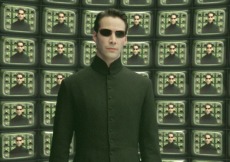
Keanu Reeves confronts The Architect in The Matrix
Reloaded. |
The biggest "hint" is Neo's power over the Sentinels. There's no clear explanation
for this. In the video game, Enter the Matrix, the Oracle (played now
by Mary Alice) explains to Logos crewmates Ghost and Niobe (Jada Pinkett-Smith)
what happened to Neo:
"He touched the Source and separated his mind from his body. Now he lies
trapped in a place between your world and ours."
This is the same explanation she gives Trinity in Revolutions (as seen
in the advertisements). Taking, then, the evidence from the Enter the Matrix
and the ads for Revolutions, it can be concluded that the ending is a
sign of what powers makes this One special. Another explanation could
be that his "connection" with Smith has enabled him to control the Sentinels.
The Architect and the Mother of the Matrix
Neo's "quest" throughout Reloaded brings him to the Source, "where the
path of the One ends," when the war will end. There he meets the Architect,
creator of the Matrix, who tells him the history and nature of the Matrix. We
learn that Neo is not the only One and that the machines have a much stronger
control over humans than what was originally thought. Zion, he reveals, is not
another simulation, but a place where the machines can control humans who reject
the Matrix program.
Who or what the Architect is remains unclear. He could be a machine projecting
itself as a man in the Matrix, or he could be another program. Neo chooses to
trust him, which would seem a mistake since the Architect could be lying to
confuse or coerce Neo into making a specific choice. However, nothing the Architect
says contradicts anything that has been said or done in the two films. There
was a previous version of the Matrix—Smith alluded to it while interrogating
Morpheus. There have been other Ones because of the Oracle's prophecy of the
return of the One (referred to by Morpheus in the first film), the Merovingian's
references to Neo's "predecessors," as well as several characters, including
Smith, "expecting" Neo as if events were "happening exactly as before" (something
Smith says to a clone early in Reloaded). Zion has been destroyed before,
as implicated in a scene in Enter the Matrix, in which Niobe encounters
an old man who says that Zion lasted only 72 hours "last time." And what the
Architect said about Trinity is true—she did die, and Neo did nothing to
stop it. He only brought her back to life after she had died.
So, if the Architect is not lying, Neo is the sixth "One" and the Matrix has
existed for more than one hundred years. The first Matrix, described as "a perfect
human world…where none suffered, where everyone would be happy" by Agent Smith,
was a failure that lead to the redesign reflecting "the varying grotesqueries
of [human] nature." This also failed, thus creating the necessity to find a
solution, which was eventually found by "an intuitive program, initially created
to investigate certain aspects of the human psyche," otherwise known as the
"mother" of the Matrix. This program "stumbled upon a solution whereby nearly
ninety-nine percent of all test subjects accepted the program, as long as they
were given a choice, even if they were only aware of the choice at a near unconscious
level."
The "choice" is free will. Humans would not accept the first version of the
Matrix because they did not have free will—they were forced to be happy,
forced to live perfect lives. The redesign similarly had no free will, because
the Architect had not yet discovered that free will was the solution to his
problem. Being "bound by the parameters of perfection," the Architect did not
allow humans to have free will because he knew that total control was perfect
and choice was imperfect. However, giving humans choice was the only way they
would accept the program.
The problem with this solution is the one percent who refuse the program. If
this one percent remained unchecked or uncontrolled, there would be "an escalating
probably of disaster"—the problem created by the Resistance. Zion and the
anomaly are the means to control the one percent. Zion is where the one percent
and all those who they free from the Matrix are controlled. They will all be
killed with the emergence of the anomaly, an unavoidable error/irrationality
in the Matrix code. The anomaly is used to restart the Matrix, and, if he makes
the right choice, to rebuild Zion for the one percent. But, again, this system
is flawed. While the anomaly can be pushed in a certain direction, the choice
to restart the Matrix is entirely up to the anomaly and not to the machines.
Thus, the anomaly may choose not to restart the Matrix. In such an event, he
will cause "cataclysmic system crash, killing everyone connected to the Matrix,
which, coupled with the extermination of Zion, will ultimately result in the
extinction of the entire human race."
Obviously, the previous Ones chose to restart the Matrix. The previous Ones
were "designed" to have a "profound attachment" to the human race, thus the
choice that would lead to its extinction was, of course, not a decision they
would want to make. The sixth One, however, presents a problem, as his experience
is "specific" to one person. Neo has been shown from the start to be antisocial.
He is an introvert who can't deal with people as well as he can computers. But
twice Neo has been successfully lured out of solitude amidst a crowd by one
person—Trinity. He may be loyal to other people (Morpheus), but he loves
Trinity the most. She has become his "humanity," and thus, when presented
with the choice to save her or save mankind, he chooses her. (This presents
a contradiction to the theory of the Merovingian and Persephone being earlier
versions of Neo and Trinity, because the previous Ones did not have a similar
experience to Neo; otherwise they would have made the same choice.) So the "fundamental
flaw" is revealed—free will, letting humans live and act the way they desire
instead of living and acting the way the Architect desires.
Some—most of whom support the Double Matrix theory—believe that the
previous Ones are still running around somewhere in the Matrix or in Zion. Everyone
from the Merovingian to members of the Zion council to Agent Smith himself have
been labeled as "Ones." Most of these theories are ridiculous, in particular
the theory that Agent Smith is a One. Smith is neither a One for humans or machines;
he is a rogue program bent on controlling the Matrix himself. Moreover, the
One has to be human (assuming Neo is human and the Double Matrix theory is false.)
The Zion Councilors as previous Ones is a great theory if one forgets the prophecy
Morpheus tells Neo. The previous "One" is dead.
Having established the truth of the Matrix and the identities of the "One"
and the Architect, who, then, is the "mother" who created the solution? She
is not the Oracle for many reasons, the most obvious reason being that the Architect
denied that she was. A popular theory regarding the Architect's "denial" is
that he reacted to the name "The Oracle," not to the idea that she was the "mother"—somewhat
of a forgivable mistake, since the Architect returned to his train of thought
after saying, "Please." But though the Oracle may be a mother figure to the
Resistance, the Oracle does not fit the description of the "mother." She is
not an investigative program, nor is she very much concerned with the human
psyche. The program that does fit the description is Persephone (Monica
Bellucci). Described by Time magazine as a "vampire of human emotion,"
Persephone is very keen on the emotions of the human characters she meets. Her
husband is a "trafficker of information," which might mean the two worked together
to investigate what made humans human. The only other possibility is that the
"mother" is a character we have not met yet.
Review
and analysis © October 2003 by AboutFilm.Com and the author.
Images © 2003 Warner Bros. All Rights Reserved.





